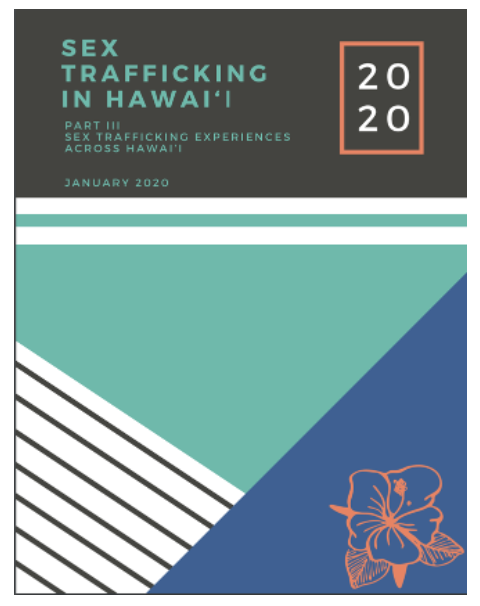New Study on Hawaiʻi and Sex Trafficking
The latest report of a new study on sex trafficking in Hawaiʻi reveals 64% of survivors identified as being all or some part Native Hawaiʻian and more widespread than many believed. The report on sex trafficking and children is part three of a study by the Hawaii State Commission on the Status of Women and Arizona State University. The first report of the study focused on the market for online sex buyers in Hawaiʻi. The second report shared 22 stories of women and girl survivors of sex trafficking.
“Trafficking of our keiki [children] is a horrible crime,” said Kupuna NaniFay Paglinawan, Member, Pouhana O Na Wāhine. “As children, they are the most vulnerable part of our community.”
The study provides a greater understanding that trafficking can occur within the state of Hawaiʻi, one island or between islands or one neighborhood, or between neighborhoods. It happens whenever an adult takes advantage of a juvenile through force, fraud, or coercion to compel that child to engage in sex for profit.
 To conduct the study, Child and Family Service administered a survey to 363 participants in their programs. Based on those surveys, Arizona State University researchers found that nearly 27% reported being victims of sex trafficking. Of those identified as survivors, about a quarter of them said they were children when it happened for the first time, and the first person who preyed on them was a family member — either a parent, guardian, sibling, grandfather, or uncle.
To conduct the study, Child and Family Service administered a survey to 363 participants in their programs. Based on those surveys, Arizona State University researchers found that nearly 27% reported being victims of sex trafficking. Of those identified as survivors, about a quarter of them said they were children when it happened for the first time, and the first person who preyed on them was a family member — either a parent, guardian, sibling, grandfather, or uncle.
The study determined that of the participants who said they were sex trafficked as a child; the average age is just under 12 years old. More than 75% of all sex trafficking victims reported being homeless, and 64% of survivors identified as being part Native Hawaiian.
“The data confirms what our community providers have instinctively known — this is a very real problem,” said Karen Tan, President and Chief Executive Officer of Child and Family Service. “We are engaging with all the necessary agencies and organizations to collectively address this problem. This study identifies the volume of sex trafficking in our most vulnerable populations and demonstrates the need to respond to this issue immediately and provide much-needed support to survivors.”
“This is a very serious problem. We need to increase awareness of sex trafficking in our communities and develop a plan to prevent it,” said Rosemond Pettigrew, Board President, Pouhana O Na Wāhine. “By doing this we can increase community partnerships with state services providers and law enforcement. This hard issue would be one focus of the Native Hawaiian Resource Center we are organizing to develop.”
It is a common view that sex trafficking of Native Hawaiian women and girls is not new. One of the first cases dating back to 1825, when American whalers trafficked a young girl.
“Children are very loving. They want affection and to do good. Traffickers use these qualities to lure and exploit them into selling their bodies in exchange for cash, food, clothes or just a place to stay,” said Dayna Schultz, Member, Pouhana O Na Wāhine. “Everyone should read these reports and understand the danger our children and communities are facing.”
Alert: If you are a victim of or suspect any sex trafficking activity, call 911 immediately. To report child trafficking, call the Child Welfare Services’ child trafficking hotline. On Oahu, that number is (808) 832-1999, or 1-888-398-1188 for the neighbor islands. You can also contact your county police department — anonymously or in person — or call the National Human Trafficking Hotline at (888) 373-7888.
1. https://humanservices.hawaii.gov/wp-content/uploads/2018/09/Demand-Study-Part-1-Sex-Trafficking-Research-in-Hawaii-FINAL-DESIGNED-091318.pdf
2. https://humanservices.hawaii.gov/wp-content/uploads/2019/01/Executive-Summary-Part-II-Sex-Trafficking-in-Hawaii-.pdf
3. Noelani Arista, Captive Women in Paradise 1796-1826: The Kapu on Prostitution in Hawaiian Historical Legal Context, American Indian Culture and Research Journal: 2011, Vol. 35, No. 4, pp. 39-55, https://uclajournals.org/doi/abs/10.17953/aicr.35.4.4268810535747523.





